The Rebel Alliance and the Galactic Empire. The remnants of Humanity and the Cylons. The Federation and whatever race happens to be attacking them at the time. Stargate Command and the Goa’uld, Replicators, Wraith, and whatever else feels like testing MacGyver’s skill with a P90. The entertainment industry is no stranger to coming up with new science fiction stories that have their share of space battles, and I soak most of it up because darnit, why not? As such, my love for science fiction drew me once again to another space war themed game called Star Borders: Humanity.
Star Borders: Humanity is a two player game that places one player in the role of the Free People’s Alliance and the other in the role of the Grand Imperium. Players will be able to choose from one of four scenarios and attempt to have the most victory points by the time the game ends, mainly by defeating enemy fleets in combat and controlling planets. Each scenario is set up differently and has its own quirks, so please be advised that the below rules and gameplay primer will only cover the easiest of the four, “The First Frontier War”, though it should still provide you with the basic idea of how the others play out.
Before we begin, I’d like to once again thank Stephanie Marroquin from Victory Point Games for sending me a free copy of Star Borders: Humanity for me to review.
Components
Maps – The game contains home sector and neutral sector maps, which fit together in various ways depending on what scenario you are playing. Planets in home sectors are either red or blue (depicting their individual starting factions) and neutral sectors remain colorless, though any planet can change hands multiple times throughout the game.
Scenario Sheets – Each of the four scenario sheets describe a different game setup. Some introduce special rules or events that occur during the game.
Play Aid Mats – There are two play aid mats that assist players in keeping track of the rules as they play. One of them includes a countdown timer track which signals the game’s end after a certain point.
Markers & Tokens – There are square ship markers and circular control markers of each color that both sides will be using to move ships around and mark territory, respectively. Each player receives a token of their color to track their logistic points, which are used to purchase & move ships, buy development cards, and other various things.
Development Cards – These are purchasable during the game and provide players with unique abilities.
Die – While the manual says that a six-sided die is not included, the game did come with one…though more on that in the review.
Setup & Gameplay
As mentioned before, game setup will vary from scenario to scenario. In “The First Frontier War”, players set up the home sector and neutral maps according to the scenario sheet, including the starting ships and their locations. Each player gets one development card and the starting player is chosen randomly.
A player’s turn consists of the following:
1. Action Phase – The player may buy a development card, replace a destroyed ship, or repair a damaged ship at a cost of logistic points (LP). A player’s LP is determined mainly by the planets and asteroid fields that they have under their control. If he/she has any LP left, they may move their ships, not exceeding the engine values listed on the individual ship markers.
2. Combat Phase – Once movement is completed, if any opposing ships are in the same system (with the exception of deep space), they do battle. Combat occurs over a series of phases, giving players options like retreating and attacking in groups or individually.
3. Housekeeping Phase – The player earns LP and adjusts the track accordingly, based on the status of their faction and their relation to things happening on the battlefield.
The other player takes their turn in this fashion, but moves the game turn marker down the countdown track. Towards the end of the track, a die will be rolled and depending on its value, may end the game early. Whoever has the most victory points at the end of the game wins.
The above is simply an overview of the “The First Frontier War” scenario. To see more about the game’s rules in detail, you can view the manual here:
The Review
I have to say that I really liked how different the two factions played. The Grand Imperium’s ships are generally more powerful, but have less to work with. The Free People’s Alliance have more ships and a larger LP pool, but they are much weaker in combat. This forces players to adapt a bit and take into account their faction’s strengths and weaknesses. I also enjoyed the freedom I had in coming up with my own scenarios. The four scenarios that come with the game do a good job in mixing things up, but players are free to come up with their own.
The components are simplistic but do their job well. I didn’t have any issues in understanding each ship’s values nor did I have trouble seeing them. Like in “Final Frontier”, the manual mentions that no dice were included, yet there was one in the bag. However, it proved to be so small that I couldn’t use it. I’m not sure why a smaller die was used, nor why one was originally left out of the game. A game should contain everything you need to play it. Sure, you could run down to your local dollar store and pick up six dice for a buck or something like that, but the point is, you shouldn’t have to.
Vinnie (11) took charge of the Free People’s Alliance (Blue) in “The First Frontier War” scenario and quickly sought neutral planets so that he could raise his LP count every turn. Both of us expanded towards the middle and game turns were flying by. It came down to one giant battle in the middle of the board, which he won, due to some bad die rolls on my end. We only had two skirmishes during the whole game, so next time we may extend the countdown tracker, just so that we can get more game time in. It took us about twenty minutes, if that, to blow through eight turns.
Overall, Star Borders: Humanity is a decent space war sim that gives players quite a few options. I’d be interested in seeing more content and a wider variety of ships. If you’re looking for a quick two player skirmish in space, give this game a good once-over!
Final Verdict: 6/10
—
You can find more information on Star Borders: Humanity by visiting the Victory Point Games website or on Board Game Geek, located here:

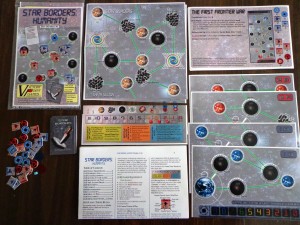

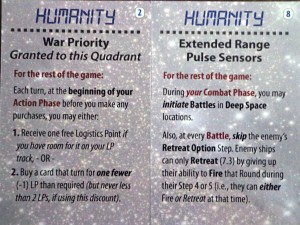
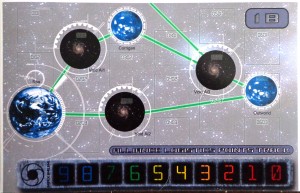

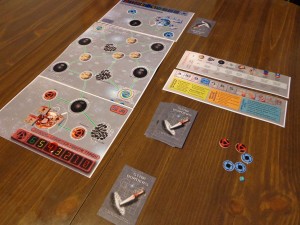
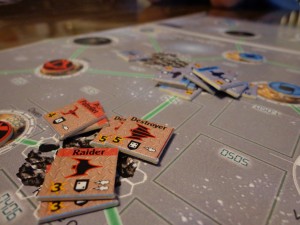

Like in “Final Frontier”, the manual mentions that no dice were included, yet there was one in the bag. However, it proved to be so small that I couldn’t use it. I’m not sure why a smaller die was used, nor why one was originally left out of the game. A game should contain everything you need to play it. Sure, you could run down to your local dollar store and pick up six dice for a buck or something like that, but the point is, you shouldn’t have to.
The manual is correct; no dice are supposed to be included. You will need to provide your own. The one(s) that are included are a gift.
The game comes packaged flat, in a nice poly-bag, and is mailed in a sturdy, protective padded envelope. Now, imagine if we put in a half-dozen 3/4″ solid, square six-sided dice in that package… The postal elephant that sits on all such packages will crush those solid cubes into your paper-and-cardboard game and will have well and truly destroyed it, denting it beyond all use, before it ever arrives at your address.
If/when this game is available in a boxed format, then including dice will not be a problem. Until then, we can’t have large dice destroying the game in transit.
Alan Emrich
Victory Point Games
I understand what you are saying, but there are consumers out there that feel that when they purchase something, that all of the components should be there. I feel that it is necessary to inform interested parties of things like this, just so that they know what they are receiving should they drop money on the product.
Thanks for letting me know that there are boxed versions in the works, I think that they will be received well.